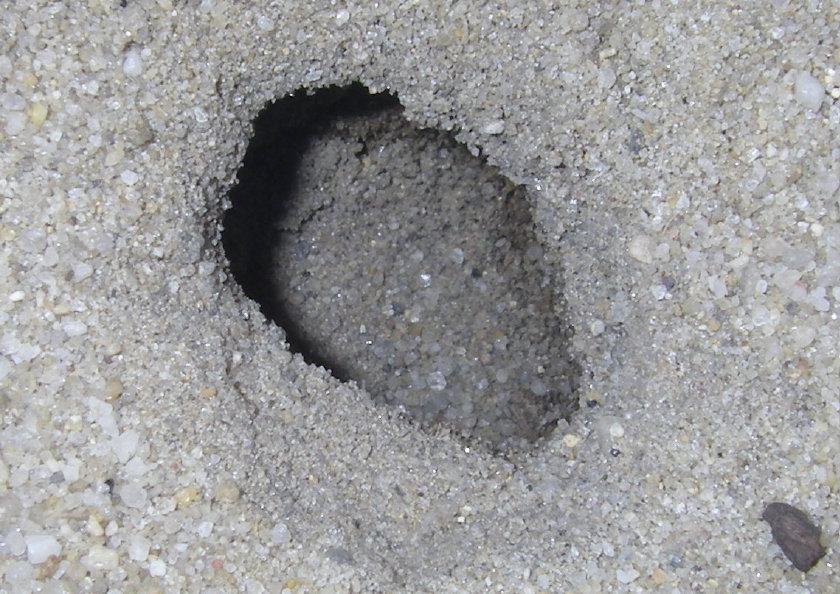Emergence Hole About 1.5 Inches Long x 0.5 Inch Wide
Today brought a cool overcast to the Outer Cape as September’s autumn preview now grips the Land of Ooze. Hatching had slowed to a crawl as temperatures fell and clouds rose. So, we expected little from our afternoon rounds that began at Griffin Island where the truly northernmost terrapins in the world reside, stopped by Indian Neck on the north shore of Blackfish Creek and crossed over to Lieutenant Island on the south shore.
Another Emerge Hole, Same Size as Previous
Surprise! Emergence holes and emerging nests greeted us at every stop. Two on Griffin Island: one on the shoulder of an asphalt road and only about five inches deep because mother hit pavement, and the other along a boardwalk leading to the Herring River salt marsh. Eight live hatchlings emerged from the first nest and four succumbed to maggot depredation. Sixteen hatchlings escaped from the second nest into the salt marsh.
Camouflaged Emergence Hole
When I spotted the emergence hole for the second nest, I burst into laughter. A clump of pine needles had obviously been blown atop the hole by a recent storm. But it looked so carefuly placed so as to camouflage the nest and give emerging hatchlings cover from predators as they bolted into the safety of the Herring River marsh.
I also hadn’t noticed until this posting the near identical similarity in shape of the first two emergence holes pictured above. Sure, these critters are nearly identically sized at the hatchling stage, ~ 2.7 cm carapace length and ~ 6 grams mass; but after observing the chaos of an emerging nest (see the video clip below), I’m amazed by the twin shapes.Â
Count the Heads as They Emerge
We arrived at the Indian Neck nest just as the clutch began to broil. Heads popped up for a peek of their brave new world and quickly receded again under the dirt … to be replaced by a new set of darting eyes. Try keeping a headcount as babies appear. These thirteen lively characters could easily convert this performance art into a comedy circus routine that I would gladly book for a World Tour.
Hatchling Emerges from Nest; Note Pointy Egg Tooth
The shifting dune sand on the Hook of Lieutenant Island makes finding an emergence hole impossible, except immediately after a drenching rain storm. No such meteorological assist was in the cards. One hundred percent overcast, but no rain. Still, luck played in our favor. We first spotted a collection of hatchling tracks slaloming across the dune slopes. Tracing these signs back to a convergence point, we ran smack dab into a terrapin hatchling just emerging from the nest. Behind this baby, three more waited their turn to make a break for freedom.
Nest Completely Depredated by Fly Maggots
While we rejoiced in more than 75 live emerged hatchlings documented during our rounds this afternoon, we did have one sad encounter. Nest 210, which we had been monitoring since June on the Boathouse dune, had been completely depredated by fly maggots that had consumed all the hatchlings, leaving behind only a thin layer of each carapace.
Tags: Blackfish Creek, Boathouse, emergence holes, Griffin Island, hatchling, Headcount, Herring River salt marsh, Hook, Indian Neck, Land of Ooze, Lieutenant Island, maggot depredation, meterolgical, northernmost terrapins, Outer Cape September, temperatures




